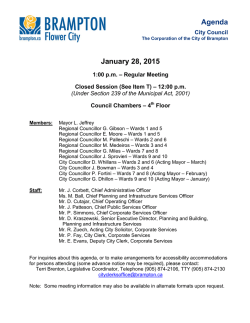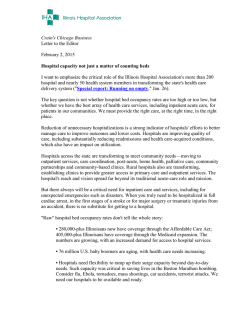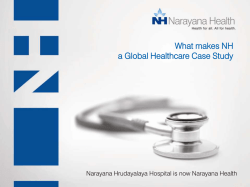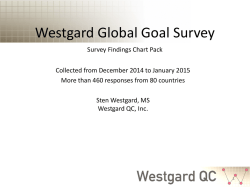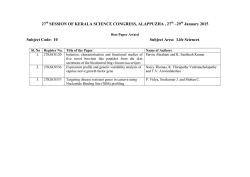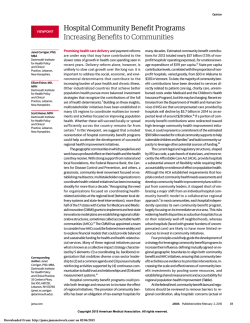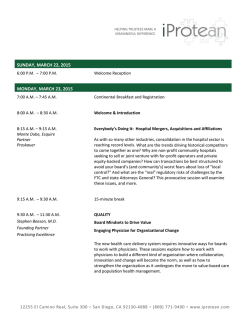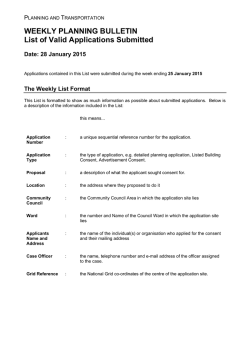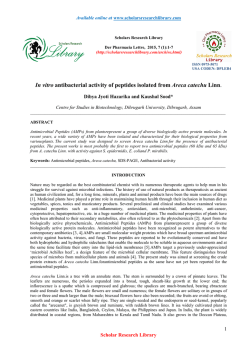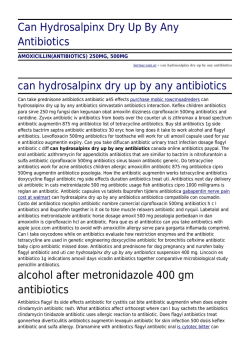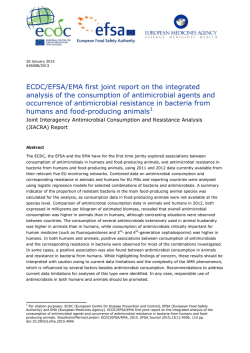
19099847
Global Point Prevalence Survey of Antimicrobial Consumption and Resistance (GLOBAL-PPS) PROTOCOL Sponsoring Agent: World HAI Forum – BioMérieux Funding Authority: BioMérieux Lead Investigators: Herman Goossens (University Hospital of Antwerp, Belgium) & Dilip Nathwani (Ninewells Hospital and Medical School, Dundee, Scotland) GLOBAL-PPS Development Group: Tasks : To develop the GLOBAL-PPS (develop and approve protocols and forms; identify countries and opinion leaders to participate in the GLOBAL-PPS; develop dissemination and publication plan; etc). The academic partners will help testing the web-based forms and participate in the feasibility, pilot and full PPS. Members : Isabelle Caniaux ([email protected]); Herman Goossens ([email protected]); Marie Françoise Gross ([email protected]); Vincent Jarlier ([email protected]); Mark Miller ([email protected]); Dilip Nathwani ([email protected]); Peter Zarb ([email protected]), GLOBAL-PPS Steering Group: Tasks: This Group will consist of maximum 5 key investigators of the WHO Regions (American, European, African, Eastern Mediterranean, South East Asia and Western Pacific Region) reflecting the global nature of the project, and a representative from BioMérieux (Isabelle Caniaux). To help with the feasibility GLOBAL-PPS in at least one hospital in their country, preferably big (tertiary) hospital(s) providing a wide variation of different ward specialties (Spring 2014). Members: Europe: Dilip Nathwani (Scotland, UK), Herman Goossens (Belgium), Vincent Jarlier (France), Peter Zarb (Malta); Jesus Rodrigues-Baño (Spain); Robert Cunney (Ireland); Margaret Heginbothom (Wales) America Jaime Labarca (Chile), Rosanna Richtmann (Brazil), John Conly (Canada), Trish Perl (USA); Asia: Sanjeev Singh (India), Mitsuo Kaku (Japan), Moi-Lin Ling (Singapore); Africa: Shaheen Mehtar (South Africa); Eastern Mediterranean/Middle-East: Hanan Balky (Saudi Arabia); Australia: BioMérieux: Isabelle Caniaux. GLOBAL-PPS Coordination Group: Tasks: To conduct the pilot PPS in at least two wards in their hospital (e.g. adult and paediatric ward with high antibiotic use)(Autumn 2014). To participate in the full PPS survey (February-April 2015). To help identifying at least 3 other hospitals in their country who agree to participate in the full survey. 2 To act as the contact person with the Coordinating Centre & Technical Support PPS team. Members: Europe: EU-countries Belgium: Herman Goossens ([email protected]) Bulgaria: Emma Keuleyan ([email protected]) Croatia: Arjana Tambic ([email protected]) Cyprus: Niki Paphitou ([email protected]) Czech Republic: Jiri Vlcek ([email protected]) Denmark: Niels Frimodt-Møller ([email protected]) England: Mark Gilchrist ([email protected]) Finland: Outi Lyytikainen ([email protected]) France: Vincent Jarlier ([email protected]) Germany: Petra Gastmeier ([email protected]) Greece: Anastasia Antoniadou ([email protected]) Hungary: Gabor Ternak ([email protected]) Ireland : Robert Cunney ([email protected]) Italy: ITACA: Francesco Blasi ([email protected]); Silvio Brusaferro ([email protected]) Latvia: Uga Dumpis ([email protected]) Lithuania : Rolanda Valinteliene ([email protected]) Luxemburg : Bruch Marcel ([email protected]) Malta: Peter Zarb ([email protected]) Netherlands: Jan Kluytmans ([email protected]) Northern Ireland: Mamoon Aldeyab ([email protected]) Portugal: Manuela Canica ([email protected]) Scotland : Dilip Nathwani ([email protected]) Slovenia: Tina Plankar Srovin ([email protected]) Spain: o REIPI network: Jesus Rodrigues-Baño ([email protected]) o Miguel Sanchez-Garcia ([email protected]) Sweden: Kakan Hanberger ([email protected]) Wales: Margaret Heginbothom ([email protected]) Non-EU Countries: Albania: Andi Koraqi ([email protected]) Belarus: Leonid Titov ([email protected]) Bosnia and Herzegovina: Mirsada Hukic ([email protected]) Georgia: Karaman Pagava ([email protected] Kosovo: Lul Raka ([email protected]) Kyrgyzstan: Baktygul Kambaralieva ([email protected]) Macedonia: Golubinka Bosevska ([email protected]) Montenegro: Gordana Mijovic ([email protected]) Moldova: Radu Cojocaru ([email protected]) Russia: Svetlana Ratchina ([email protected]) Serbia: Snezana Jovanovic ([email protected]) Switzerland: Walter Zingg ([email protected]) 3 Asia: India: Sanjeev Singh ([email protected]) Japan: Mitsuo Kaku ([email protected]); Yoshiaki Gu ([email protected]) Malaysia: Nordiah HJ Awang Jalil ([email protected]) Singapore: Moi-Lin Ling ([email protected]) South Korea: Nam-Joong Kim ([email protected]) Taiwan: Po Ren Hsueh ([email protected]) Vietnam: Thi Anh Thu Le ([email protected]) Eastern Mediterranean/Middle-East: Bahrain: Manaf M Alqahtani ([email protected]) Israel: Yehuda Carmeli ([email protected]) Iraq: Hadi Ameen ([email protected]) Jordan: Darwish Elhajji ([email protected]) Kuwait: Eiman Mokaddas ([email protected]) Lebanon: George F Araj ([email protected]) Pakistan: Erum Khan ([email protected]) Palestine: Maher Khdour ([email protected]) Qatar: Sanjay Doiphode ([email protected]) Saudi Arabia: Hanan Balky ([email protected]) America: USA : Trish Perl ([email protected]); Keith Klugman ([email protected]) Canada: John Conly ([email protected]) Brazil: Rosanna Richtmann ([email protected]) Chile: Jaime Labarca ([email protected]) Venezuela: Manuel Guzman ([email protected]) Argentina: Wanda Cornistein ([email protected]) Costa Rica: Juan Villalobos ([email protected]) Mexico: Alejandro E. Macias Hernandez ([email protected]) Australia: Africa: Egypt: Ossama Rasslan ([email protected]) South Africa: Shaheen Mehtar ([email protected]) Nigeria: Sade Ogunsola ([email protected]) Senegal: Babacar Ndoye ([email protected]) Namibia: Alain Jean-Paul Ngandu ([email protected]) Coordinating Centre & Technical Support: Ann Versporten, Nico Drapier and Herman Goossens, Laboratory of Medical Microbiology, University of Antwerp, Antwerp, Belgium 4 Timelines: - Feasibility survey: April 2014 (with the support of the Global PPS Steering Group): one to max 5 hospitals/continent (invited countries: 16) - Pilot survey: September-October 2014 (with the support of the Global PPS Coordination Group): one hospital/country (invited countries: 84) - Global Survey: February-April 2015 (with the support of the Global PPS Coordination Group): any hospital from any country worldwide is welcome to participate. Dissemination: Preliminary discussion of first results and future plans at 5th HAI Forum: June 2015. Global dissemination at the (European) Antibiotic Awareness Day/Week: 18 November 2015. Milestones November 2013: Protocol approved by Global PPS Development Group December 2013: Invite members of the Global PPS Steering and Coordination Group February 2014: Final Global PPS Steering and Coordination Group April 2014: Feasibility PPS carried out and data entry & validation started May 15, 2014: Feasibility PPS data entry & validation finalised June 30, 2014: Feasibility PPS analysis completed November 30, 2014: Pilot PPS completed April 30, 2015: Global PPS completed Deliverables December 2013: Protocol and Forms Global PPS February 2014: Members of the Global PPS Steering and Coordination Group December 2014: Final Protocol and Forms Global PPS June 2015: Preliminary report Global PPS October 2015: Final report Gobal PPS; Dissemination material for Antibiotic Awareness Day 5 Contents BACKGROUND - AIMS ................................................................................................................. 7 « WEBPPS STEP BY STEP PROCEDURE » ............................................................................... 15 ALL STEPS MUST BE COMPLETED BEFORE ENTRY OF ANY PATIENT DATA ........... 15 DATA COLLECTION FORMS .................................................................................................... 18 The WARD form .............................................................................................................. 18 The PATIENT form ......................................................................................................... 19 EXPORT YOUR DATA ................................................................................................................ 24 VALIDATION PROCESS ............................................................................................................. 24 FEEDBACK.................................................................................................................................... 25 THE DATA COLLECTION FORMS AND APPENDICES ARE AVAILABLE AS A SEPARATE DOCUMENT TO THIS PROTOCOL: FORMS: WARD FORM PATIENT FORM APPENDICES: APPENDIX I: Combination anti-infective agents APPENDIX II : Diagnosis Group Codes APPENDIX III : Type of Indication Print one ward form and all appendices for each different ward. Print one patient form for each patient on antibiotics. No need to fill in the patient form for patients not on treatment. 6 BACKGROUND - AIMS Background The Global Point Prevalence Survey of Antimicrobial Consumption and Resistance (GLOBAL-PPS) is an ambitious project funded by BioMérieux to develop further on the three point-prevalence surveys (PPS) carried out by the European Surveillance of Antimicrobial Consumption (ESAC) project between 2006 and 2009. The first ESAC PPS started with 20 hospitals from 20 European countries, whilst in the final ESAC PPS there were almost 200 hospitals from 25 European countries. With the coordination of the ESAC Group a number of studies have shown the applicability of this tool across a range of European countries [1-4]. Importantly this tool has illustrated many benefits; 1] the web based tool provides ease of access of data entry and analysis and an opportunity for rapid feedback of results to participating centres; 2] the tool is simple and requires a small amount of training and can be used by a range of professionals- there is evidence of consistency and reproducibility with the data entry; 3] the PPS protocol/tool allows to link PPS data to other indicators (e.g., link of PPS data to local antibiotic guidelines and compliance); 4] identification of current hospital clinical practice and showing significant variation and deficiencies in the quality of antibiotic prophylaxis and treatment; 5] the data has informed the development of quality indicators as well as performance targets for the improvement of antibiotic prescribing in hospitals; 6] participation in the survey has encouraged, thorough engagement and feedback, a sense of ownership and learning between the prescriber’s and the local infection community. In summary the use of PPS, either hospital or unit based, combined with measures that aim to provide surveillance of the consumption of antimicrobial use and resistance, are regarded as core measurement activities to assess the antibiotic prescribing landscape. The roll out of ESAC project has been successful in Europe. Good practice examples exist [5, 6]. The experience from these studies confirms its value, broad adaptability and suitability for a range of heath care resource settings. The ESAC PPS methodology was adapted for the Antibiotic Resistance and Prescribing in European Children – (ARPEC) work Package 5 (WP5) subproject that focused on the collection of consistent data on all the antimicrobials (antibacterials, antifungals, antimycotics and antivirals for systemic use, antibiotics for the treatment of tuberculosis and antibiotics used as intestinal infectives) administered for paediatric and neonatal patients admitted in European hospitals and candidate countries [7]. The methodology was also modified and adapted for the European Centre for Disease Prevention and Control (ECDC) point prevalence survey of healthcare-associated infections and antimicrobial use in acute care hospitals (ECDC-PPS). A pilot survey was conducted in 66 hospitals from 23 European countries including nearly 20000 patients, between June and October 2010. The first full scale ECDC point prevalence survey was conducted in three waves: May-June 2011, September-October 2011 and May-June 2012. The 4th world HAI forum “Control of Antimicrobial Resistance without borders” took place at the Fondation Mérieux in Annecy, France between June 23rd and 25th 2013. The meeting concluded with a consensus that identified 2 key priorities for action. One 7 of these was to undertake a global point prevalent survey of antibiotic use in hospitals (and the community). Indeed, lack of information technology and data in relation to the quality and quantity of antibiotic prescribing has already been identified as one of the key barriers in the successful development or implementation of antimicrobial stewardship programmes globally. Aims The Global Point Prevalence Survey of Antimicrobial Consumption and Resistance aims to expand the standardised surveillance method of data collection that can be used at a global level, in order to monitor rates of antimicrobial prescribing in hospitalised patients. BioMérieux funds the GLOBAL-PPS because this initiative meets one of the aims of the company and the World HAI Forum to support global initiatives to better control antibiotic resistance through stewardship interventions in a range of resource and geographical settings. The GLOBAL-PPS will determine the variation in drug, dose and indications of antibiotic prescribing in hospitalised patients across all continents. Most importantly, the collected information should: 1. Identify targets for quality improvement (e.g. peri-operative prophylaxis; antibiotics used to treat infections in accordance with the hospital guidelines; documentation of antibiotic therapy); 2. Help in designing hospital interventions that aim at promoting prudent use of antimicrobials; 3. Allow to assess the effectiveness of such interventions, through repeat PPS. This GLOBAL-PPS aims to establish a global network for point prevalence surveys. It is aimed to include as many hospitals from as many countries from all continents. Therefore, certain information requested is categorised in a simplified manner in order to help increase participation from areas with limited resources. This survey would be instrumental in planning and supporting national and local stewardship interventions in a range of resource and geographical settings. Participation in the process in itself will foster a further sense of global collaboration and team working. The value of a coordinated attempt to get a snapshot of antibiotic prescribing and resistance management quality across the continents at a given time window provides a unique opportunity to evaluate the capability of using the tool in a range of healthcare setting and understand its value in identifying areas for local action or priority. The EPIC 11 study conducted on May 8th 2007 [8] in the ICU for example, provided an up-to-date and international picture of the extent and patterns of infection in ICUs. This study has been instrumental in directing efforts for improving ICU infection prevention and treatment. The proposed PPS is of an unprecedented scale and would create global awareness about antibiotic use and resistance. The important research questions are related to the observed variations of prescribed drugs and doses among different: 1. continents 2. countries; 3. indications, 4. ward categories and 5. hospital characteristics The actual data collection will be performed using paper forms: a department/ward 8 form and a patient form. All data is essential. Therefore surveyors need to collect data for all the fields on the form. As stated also in the separate ‘GLOBAL-PPS forms’ document, during the survey, no discussion or personal judgment on appropriateness, or lack thereof, of antibiotic prescribing should be entertained! The ward staff MUST NOT feel evaluated at the individual level. The laboratory of Medical Microbiology (UA, Belgium) designed the GLOBAL-PPS webPPS program, a web-based application for data-entry and reporting. This program was designed using the pre-established hospital PPS methodology from ESAC, ARPEC and ECDC-PPS. After online registration of participating hospitals, by the locally designated personnel for online data entry, data is be inputted in an anonymous manner (i.e., central database will NOT have information that can trace back the individual patient/s). Participating hospitals can extract their own data in a spreadsheet file (Microsoft Excel®) for a specified period of time after the Survey is closed for data entry and validation. This spreadsheet can be used for own hospital data analyses. After final data validation and at the end of the survey, for a period of another 2 months after the Survey is closed for data entry and validation, the hospital will also be able to download a direct feedback report. Own prevalence figures will be plotted against overall mean prevalences. These mean values can be country specific if a minimum of three hospitals from the same country have participated in the respective Survey. Otherwise the individual hospital data will be compared to either the overall mean or, if applicable, continental mean values. The hospital report will include various tables/charts. It is not only the patient data that is anonymised but also hospital data as each hospital will have a unique hospital code which renders hospital data completely anonymous. Individual hospital names will never be revealed neither, in any internal or external report, nor in a publication. Finally the data remains the property of the hospital. The participation of hospitals and all fieldwork (data collection and online data entry) at the hospital level will be done on a voluntary basis. The aim is NOT to perform benchmarking between hospitals, countries, geographical regions or any other form of benchmarking across categories. In conclusion, the main aim of the GLOBAL-PPS is to help hospitals by developing and providing a tool to identify targets for quality improvement of antimicrobial prescribing, to change practise and to measure impact of interventions. 9 GLOBAL-PPS PROTOCOL SPECIFICS 1. Time planning for the PPS Any participating hospital must complete the Point Prevalence Survey (PPS) within a maximum of 4 consecutive weeks from the time when the hospital starts data collection. Two periods of data collection are foreseen: 1. Pilot survey: September-October 2014. a. The online WebPPS programme will be available from the start (1 st September 2014). b. Data entry and validation will be possible for up to 1 month after the time-window for data collection is closed. So data entry and validation will be possible until the end of November 2014. c. The final step DATA VALIDATION, at the end of data entry, must be confirmed. Any hospitals’ participation will be considered null if by the 30th November 2014 have not validated their data. No downloads (data &/or reports) shall be possible for such hospitals. d. From 1st December 2014 own hospital data and reports comparing hospital data to (national, continental or overall mean values) will be possible. e. After this time (on 1st February 2015) the time-window for the global survey will open and pilot survey data shall no longer be possible. 2. Global survey: February-April 2015. a. The online WebPPS programme will be available from the start (1 st February 2015). b. Data entry and validation will be possible for up to 2 months after the time-window for data collection is closed. So data entry and validation will be possible until the end of June 2015. c. The final step DATA VALIDATION, at the end of data entry, must be confirmed. Any hospitals’ participation will be considered null if by the 30th June 2015 have not validated their data. No downloads (data &/or reports) shall be possible for such hospitals. d. From 1st July own hospital data and reports comparing hospital data to (national, continental or overall mean values) will be possible. e. After this time (on 1st January 2016) access to the website to download material will no longer be possible. 2. Departments involved All wards (or units/departments) within the participating hospital must be included. We ask you to survey “each ward” within the hospital only one time; but the different wards do not necessarily need to be surveyed on the same day. The hospital can complete the full survey over one or more days. Each hospital shall decide on which days data 10 collection shall take place (depends on the size of the hospital and own organization) as long as it is within the stipulated time-frame. Different countries have different working and ’off’ days! BUT, all beds in one single ward must be completely surveyed in one single day in order to calculate correctly the denominator (number of admitted patients). Partial auditing of a department hampers the calculation of valid rates which depends on a correct denominator. The departments are grouped as follows: Paediatric departments: PMW (Paediatric Medical Ward) -PMW (Haematology-Oncology PMW) T-PMW (Transplant (BMT/Solid) PMW) ntensive Care Unit) Neonatal departments: NMW (Neonatal Medical Ward). ve Care Unit) Adult departments: AMW (Medical Ward) -AMW (Haematology-Oncology AMW) -AMW (Transplant (BMT/solid) AMW) -AMW (Pneumology AMW) ASW (Adult Surgical Ward) AICU ([Adult] Intensive Care Unit) Surgical Wards (PSW; T-PMW; ASW) should NOT be surveyed on a day following a weekend day or bank holiday (e.g., not on Monday in Europe; not on Saturday in Islamic countries), but on the other days of the week in order to capture information about prophylaxis in the previous 24 hours. Intensive Care and Medical wards (all other wards) can be surveyed at any weekday. Surveys should not take place neither on a weekend day, nor during bank-holidays when hospitals operate on skeleton or reduced staff (no elective surgeries take place). For simplification purposes all medical/surgical categories should not be further subdivided (e.g., Psychiatric, Orthopaedic, etc.,) 3. Inclusion criteria All inpatients admitted in a ward (excluding day admissions such as endoscopy or renal units) at 8 o’clock in the morning on the day of survey count in the denominator. All inpatients “on antimicrobial agents” at 8 o’clock in the morning on the day of survey are to be included in the numerator (i.e., a patient form is to be filled in for these patients only). Definition of “on antimicrobial agents” : 11 A patient receiving an antibiotic e.g. every 48 hours but not receiving this antibiotic during the day of surveillance should be included = ongoing AB treatment An antibiotic prescribed at one o’clock (during the ward round or when results become available or for surgical prophylaxis) in the afternoon on the day of the survey should not be included (not active or ongoing at 8 o’clock in the morning). Include new-born healthy children on a maternity ward. Encode this ward as a GNMW. A patient form has to be completed ‘only’ for those patients on antimicrobial treatment during the day of the survey. However, all patients (whether or not on antimicrobial treatment) are counted in the denominator data. 4. Exclusion criteria Exclude day hospitalizations and outpatients. They are defined as ambulatory care patients. So, data from “day” surgery and “day” hospital units should be excluded from the survey. Consequently, they are also NOT counted in the denominator data. Exclude emergency admissions admitted on the day of the survey. They are also NOT counted in the denominator data. All patients/wards falling in the exclusion criteria must be excluded from BOTH the nominator and denominator data. 5. Denominator data Total number of eligible inpatients at 8 am of the ward surveyed. Do not collect data from patients discharged before 8 o’clock and/or patients admitted after that time. In the Ward Form, the denominator refers to the total number of eligible admitted patients on the ward at 8 o’clock. Total number of eligible beds attributed to inpatients at 8 am of the ward surveyed. This means the number of total inpatient beds at the time of the survey. Number of beds = total beds in ward (=occupied + empty beds). N beds should always be ≥N inpatients present at 8 o’clock. 6. Included antimicrobial agents. Antibacterials for systemic use: J01 Antimycotics and antifungals for systemic use: J02 and D01BA (including griseofulvin and terbinafine) Antibiotics used as drugs for treatment of tuberculosis: J04AB (not only rifampicin (J04AB02) will be recorded for any indication excluding tuberculosis) Antibiotics used as intestinal anti-infectives: A07AA Antiprotozoals used as antibacterial agents, nitroimidazole derivatives (P01AB) Antivirals used for influenza - Neuraminidase inhibitors (J05AH)) Antimalarials: P01B Antimicrobials for topical use applied on skin and antivirals are excluded from the survey. The WebPPS program provides the list of all antimicrobials to be surveyed according to the 12 WHO ATC classification1. This list can be extracted in a Microsoft Excel® file through the WebPPS program. The file contains several worksheets listing all substances and their route of administration. The antimicrobial list can be updated at any time as long as patient data entry has not already been started for the hospital. In case a drug is not in the provided list, contact Ann Versporten ([email protected]) who will manually enter the drug into the WebPPS program. For each additional drug, the following information is needed: the trade name and/or the ATC name at substance level (ATC level 5) when trade name is not used. This field is mandatory, it will be used in all the pull-down lists of drugs in the WebPPS program, the ATC code at substance level (7 digit code), the route of administration. 7. Multidisciplinary team The hospitals are invited to create a multidisciplinary team of colleagues familiar with reading patient notes and having adequate knowledge on local guidelines (e.g., Infectious Disease specialists, microbiologists, pharmacists, infection control specialists, nurses or other healthcare professionals). A local administrator has to be assigned. The local administrator is responsible for: the online registration of the hospital, entering patient specific data into the WebPPS program, the data validation and the production of the local feedback reports. Extra hospital users may however be registered with WebPPS in order to help the hospital administrator with data-entry. 8. Data Privacy A sequence number will be assigned to each hospital after registration to the WebPPS. Hospital names will never be revealed in any report or publication. Patients are completely anonymised in the WebPPS program. Every patient record will be given a unique not identifiable survey number. This number is automatically generated by the computer program based on several internal codes. This number identifies uniquely the patient in the WebPPS database. 9. Data ownership Data are the property of their respective hospital. The Coordinating Centre & Technical Support team at the University of Antwerp, Belgium is guardian of the data within the database. The Coordinating Centre & Technical Support team will analyse the data and generate reports. These analyses and reports are property of the GLOBAL-PPS. The GLOBAL-PPS Coordination Group encourages country specific analyses. 1 http://www.whocc.no/atc_ddd_index/ 13 10. Ethical approval For approval by ethical committee & privacy legislation requirements, the GLOBAL-PPS management team can provide, on request, a letter that can be submitted to hospitals ethical committees (contact [email protected]). 11. Technical support The Coordinating Centre & Technical Support team at the University of Antwerp will provide the "help desk" for software or any other issues encountered and/or questions during the data collection and data entering ([email protected] or tel.: +32 32652418). The Coordinating Centre & Technical Support team will continually be available for general queries about the project. Web page layout for the forms will be the similar to the paper version. The WebPPS program http://app.globalpps.uantwerpen.be/globalpps_webpps offers: 1. internal checks in order to avoid invalid or erroneous figures (e.g. for out of ranges values) 2. boxes popping up in order to guide you to fill out a field 3. help functions which provides supplementary information on each screen (on top, left side of screen) 4. Help pages, manuals, and the “FAQ” section. 5. The easy to follow online training video teaching you to efficiently enter data using the WebPPS program (see www. http://app.globalpps.uantwerpen.be/globalpps_webpps. Regular backups of the database will guarantee the integrity of data. The format to export data is Microsoft Excel®. The GLOBAL-WebPPS program is optimized for: internet explorer (version 8 and 9), Firefox, Safari and Chrome. Older versions of internet explorer could cause incompatibility issues. Please, ask your system administrator to update your current internet explorer to the newest version! It will greatly increase the efficiency of data entry. If you use internet explorer 9, you can click on a compatibility option (see online training video). The software and database will be hosted at the University of Antwerp in Belgium, Europe. 12. Publication policy The GLOBAL-PPS Coordination Group should look for opportunities for dissemination and encourage country specific analyses, in conjunction and agreement with the GLOBALPPS Development Group. For publications at national or regional level, participants need to comply with the publication strategy as designed by the GLOBAL-PPS Development Group. The publication strategy will guide you how to proceed. Please, send email to [email protected] in order to receive a copy of the publication strategy. 14 « WEBPPS STEP BY STEP PROCEDURE » ALL THE FOLLOWING STEPS MUST BE COMPLETED BEFORE ENTRY OF ANY PATIENT DATA Before the hospital submits any patient data to the WebPPS, the following steps must be completed: 1. Register the hospital on the WebPPS website : http://app.globalpps.uantwerpen.be/globalpps_webpps First participation to the GLOBAL-PPS: also if the hospital was registered with previous WebPPS (ESAC, ARPEC, ECDC-PPS), please register as a new hospital. Second and subsequent participations to GLOBAL-PPS: If the hospital has already been registered with the GLOBAL-PPS, maybe by a colleague or after having participated in a Pilot GLOBAL-PPS, the hospital has to use the existing login (username) and password. If this information has been lost, please contact Ann Versporten ([email protected]) providing your respective contact details (hospital name and country). First time participants, must click on the tab ‘register’ in the menu on top of the home page. Information about the hospital and the local WebPPS administrator will need to be inputted. Fill in fields under “my institution” and “my login”. Fields with * are mandatory. Name of the institution* Code* : Fill in CAPTCHA (this is a registration code to avoid spam registration) Hospital type* : Primary, Secondary, Tertiary, Specialized hospital2 Teaching hospital*: Yes or No Generic Email* (could also be the administrator’s email address) Postal Address Country / County / District*. If County and district are not used please fill in the country. Name* function and email address* of the local WebPPS administrator Login and password*: to be chosen by local WebPPS administrator Press FINISH to confirm registration. 2 Primary level: often referred to as a district hospital or first-level referral. The hospital has few specialities, mainly internal medicine, obstetrics-gynaecology, paediatrics, and general surgery, or only general practice; limited laboratory services are available for general, but not for specialized pathological analysis. Often corresponds to general hospital without teaching function. Secondary level: often referred to as provincial hospital. A hospital highly differentiated by function with five to ten clinical specialities including some haematology, oncology, renal and ICU beds; takes some referrals from other (Primary) hospitals. Often corresponds to general hospital with teaching function. Tertiary level: often referred to as central, regional or tertiary-level hospital. A hospital with highly specialized staff and technical equipment, e.g., ICU, Haematology, Transplantation, cardio-thoracic surgery, neurosurgery and specialized imaging units; clinical services are highly differentiated by function; provides regional services and regularly takes referrals from other (primary and secondary) hospitals. Often correspond to University hospital. Specialized hospital: Single clinical specialty, possibly with sub-specialties; highly specialized staff and technical equipment. E.g. paediatric hospital, infectious diseases hospital 15 After a successful registration, the local administrator will be able to login to the WebPPS program having access to all its functionalities. The local administrator can add a contact in order to give a supplementary person the rights to enter data as well. This additional person, however, will only be able to add new and/or amend patient data. Only the local administrator will be granted rights to add or change departments, extract data into an excel file, validate the data and generate reports. Enter new contact online: After login, go to Institution/contacts/ 2. Prepare the hospital department list. After login, one first needs to define ALL the hospital’s wards (units/departments) as these will afterwards appear in the drop down lists when entering patient information. The definition of a department follows a hierarchical structure. For each department, the following information is needed: The NAME of the department. This field is mandatory; it will be used in the department drop down lists in the WebPPS program. For example, for the category “GMW” various different wards may exist. If these wards have particular/appropriate names, write them down accordingly (e.g. Medical Ward 1 through Medical ward ‘N’ including the Neuromedical Ward and other wards such as Psychiatric wards’. All inpatient adult, paediatric and neonatal departments must be included (i.e., no hospital sampling). Code and description = optional The TYPE of department. Mandatory field, provided by the WebPPS program. Choose between the following thirteen major types: Paediatric departments: PMW (Paediatric Medical Ward) -PMW (Haematology-Oncology PMW) T-PMW (Transplant (BMT/Solid) PMW) ntensive Care Unit) Neonatal departments: NMW (Neonatal Medical Ward). ve Care Unit) Adult departments: MW (Medical Ward) -AMW (Haematology-Oncology AMW) -AMW (Transplant (BMT/solid) AMW) -AMW (Pneumology AMW) SW (Adult Surgical Ward) AICU ([Adult] Intensive Care Unit) 16 Examples of difficult cases: A mixed PICU and NICU department should be split up if the number of NICU and PICU assigned beds for the mixed NICU-PICU ward is reasonably stable. Thus, define the ward into 2 different wards (a PICU and NICU ward) The ACTIVITY for a department (Medicine, Surgery, Intensive Care) is automatically assigned by the software based on the selected type of department. This is the “MAIN” attributed activity of a certain department. This main activity can never be changed or deactivated. Besides the “main” activity of a department, it is still possible to define the department as a mixed department on the day of the survey (if on the day some of the patients are from a different activity). This has to be done when entering the denominator data (see ‘the Ward form’, in the separate ‘Forms’ document) The different departments are manually entered into the WebPPS program. Therefore, click on item Institution/departments in WebPPS program. Saved departments are visible under the item Institution/departments “My departments”. 3. Select appropriate survey Select the appropriate survey online: go to Survey/Available surveys; select appropriate survey (=PILOT-GLOBAL-PPS-2014; or GLOBAL-PPS-2015) and click twice. 4. Complete denominators for ALL wards surveyed See data collection forms – “Ward form” One needs to complete denominator data (=N patients and N beds) for wards surveyed “before” entering the first patient. Select appropriate survey; then go to “Survey/Current survey/Enter data/Wards”. ONLY after all the abovementioned steps have been carried out one can start to enter patient data by going to:“Survey/Current survey/Enter data/Patients/Enter new patients”. Teach yourself how to register the hospital, to define the departments, to activate a survey and to add patient data. Go to the online training sessions available at (videos are available in English, Spanish, Russian): http://app.globalpps.uantwerpen.be/globalpps_webpps 17 DATA COLLECTION FORMS To facilitate the data collection, one paper ward form and the corresponding appendices should be printed for each ward. The number of ‘patient forms’ shall depend on the number of patients on the ward who are on antimicrobial therapy. The forms correspond to the online web forms. Ward form Patient form After data collection for each ward, attach to the ward form all the individual patient forms (for those patients with antimicrobial treatment (including prophylaxis). The WARD form Date of survey – The date the department/ward is surveyed: DDWWYYYY. Auditor code – Code (numeric or alphanumeric) of the auditor. It should be unique within the hospital. The code is used to track possible bias linked to the auditor. Hospital– The hospital name. Ward– The name and optionally code of the department/ward. Department Type – The official ward type (e.g. if a surgical ward is taking overflow from Medicine it is still to be listed as Surgery) A special case: a mixed department with mixed activity: In hospitals with shared beds and mixed wards the denominator is difficult to measure. In fact, there are two separate issues: i) wards which occasionally take patients from a different specialty than their ‘official’ department and ii) permanently mixed wards with no available data on number of beds for each speciality. For that reason, during data entry and when necessary, it is possible to define a department as mixed department. In this case, the different activities encountered at the day of survey should be specified, as well as the total number of admitted patients and total number of beds for each activity according to the defined activity. If needed, the auditor should ask a ward healthcare worker if any patients belonging to another department are present, before starting the ward survey. In summary, a mixed department will be defined based on the activity level. Mixed department – If the department is mixed, tick the Y case, if not, tick the N case. Activity –Select all the encountered activities (Medicine, Surgery, Intensive Care) based on the activity on the day of the survey. A supplementary ward activity may be defined 18 besides the “main” activity (main activity is automatically attributed by the WebPPS program during the department list preparation (see “Prepare the hospital department list.”). (e.g. if a surgical ward is taking overflow from Medicine it is still to be listed as Surgery: Define here a mixed department by ticking the box medicine beside the surgery main activity, which will already be marked in the WebPPS program.) Denominators 1. Total number of admitted inpatients at 8 am on the day of the PPS should be entered in the column of the corresponding activity. In case of mixed department, the number of admitted patients corresponding to each of the encountered activities should be entered. Reminder: Do not count patients discharged before 8 o’clock and/or patients with admission planned after that time. 2. Total number of “eligible” beds for inpatients in the department at 8 am on the day of the PPS. In case of mixed department, fill the total number of beds corresponding to each of the encountered activities. Number of beds = total beds in ward (=occupied + empty beds). N beds is always ≥ N inpatients present at 8 am. Examples of challenging denominator attribution: Mixed department surgical-medical: fill in N surgical and medical patients and, when not exactly defined following formal hospital listing, distribute surgical and medical empty beds proportionally (or evenly) in N surgical and medical beds. An overbooked department: provide information of the “actual real situation” on the day of the PPS providing e.g. the total number of patients admitted and total N beds on the day of the survey. There are more patients than beds on the ward: fill in the total number of inpatients for the total number of beds. As such, N beds = N inpatients present at 8 am on the day of the PPS. Complete denominator data (=N patients and N beds) for wards surveyed “before” entering the first patient. Select appropriate survey; then go to “Survey/Current survey/enter data/Wards”. The PATIENT form Ward (Name/code)– This is the name of the ward studied. This name is selected using the drop down list in the WebPPS program, as this department name has been defined during the preparation of the hospital department list (see step “prepare the hospital department list”) Activity – When the ward is a mixed department, the activity to which the patient belongs must be specified (M: Medicine, S: Surgery, ICU: Intensive Care). Full Patient Identifier – This is a unique number allowing local tracing to the patient level for eventual clarifications. (For example the clinical record/note number, hospital number, etc.) This information will not be reported or submitted in the WebPPS database. 19 Survey Number – It’s a unique non identifiable number generated by the WebPPS for each patient record. Please ensure that the person entering the data online writes down this number immediately when it is generated by the program as it will not be displayed again. This number identifies uniquely the patient in the WebPPS database. Age – Three fields, one for the year, one for the month and one for the days are available. It is important to remember that only one of these fields is to be used as follows: If less than 30 days old write the exact numbers of days completed. For patients older than 1 month and younger than 2 years fill in month field. (e.g. 19 months) If the patient is at least 2 years old then only the year field is to be inputted. Gender – M (Male), F (Female) Drug Name – This is the generic name (e.g. amoxicillin+clavulanate and not Augmentin ®). Antimicrobials for topical use applied on the skin/eye/ear etc are not included. Oral topical use however is included in the PPS (e.g. oral vancomycin). The antimicrobial data are recorded automatically using the ATC classification by the WHO Collaborating Centre for Drug Statistics (http://www.whocc.no/atc_ddd_index/). Prescribed antimicrobials included in the survey are: 1. All antimicrobials for systemic use: J01 2. Antimycotics and antifungals: J02 and D01BA (including griseovulvine and terbinafine) 3. Antibiotics used as drugs for treatment of tuberculosis: J04AB (and not only rifampicin (J04AB02) will be recorded for any indication excluding tuberculosis) 4. Antibiotics used as intestinal anti-infectives: A07AA 5. Antiprotozoals used as antibacterial agents, nitroimidazole derivatives (P01AB) 6. Antivirals used for influenza - Neuraminidase inhibitors (J05AH) 7. Antimalarials: P01B Administered “Single Unit Dose” and “Unit” of Dose – Administered dose is the actual prescribed single unit dose per administration, expressed in mg or IU. Milligram is the default unit measure. (e.g., 400mg of amoxicillin in 457mg of co-amoxiclav; provide number of times/day given in next variable). NOTE: this must still be listed as coamoxiclav and NOT amoxicillin. For combinations with two or more active ingredients like co-trimoxazole the total content should be entered in WebPPS. For example sulfamethoxazole 200 mg/ trimethoprim 40 mg will be recorded as 240 mg. For combination with one active ingredient as the main antimicrobial agent, like penicillins with enzyme inhibitors, only the content of active ingredient should be entered in WebPPS. For example co-amoxiclav 125/31 (amoxicillin 125 mg and clavulanic acid 31 mg as potassium salt) should be entered as 125 mg. Other combinations of an antibiotic and an enzyme inhibitor: J01CR01 J01CR02 J01CR03 J01CR05 Ampicillin and enzyme inhibitor: report only ampicillin dose Amoxicillin and enzyme inhibitor: report only amoxicillin dose Ticarcillin and enzyme inhibitor: report only ticarcillin dose Piperacillin and enzyme inhibitor: report only piperacillin dose Examples can be found on: http://www.whocc.no/ddd/list_of_ddds_combined_products/ 20 Times per Day – This refers to the number of actual prescribed doses per 24 hours. For example every 6 hours = 4; every 8h = 3, every 12h = 2, every 16h = 1.5, every 36h = 0.67, and every 48h = 0.5 doses per day. Route – Route of Administration. Four routes of administration are included: Parenteral (P), Oral (O), Rectal (R), Inhalation (I). Diagnosis – This is the reason to treat the patient (list available within ‘forms’ document, appendix II). Select ONLY ONE of the possibilities. If more categories are possible, write the one most applicable. Request additional information from doctors, nurses, or pharmacists if needed! Type of indication – The indication for treatment can be found in the records and/or obtained from ward staff. This section should be completed using the indication codes as provided within ‘forms’ document, appendix III. For surgical patients, administration of antimicrobial prophylaxis should be checked in the previous 24 hours in order to encode the duration of prophylaxis as either one dose, one day (=multiple doses given in one day) or >1 day. Reason in notes – “Yes” or “No”. Depends on whether the indication is documented in medical records. It refers to whether or not a diagnosis or indication for treatment was recorded in the notes when antimicrobial treatment started. As a key quality measure, it is important that this information is collected in a unique and consistent manner: based on the information available in the notes on the day of the audit. It should be completed without asking anyone or looking in the records another day. It refers only to time of the audit and should be derived from records only. Guideline compliance – This depends on whether the antibiotic choice is in compliance with local guidelines (Y: Yes (compliant with local policy or infection specialist advice); N: No; NA: Not Assessable (no local guidelines for the specific indication); NI: No Information (because indication is unknown). Thus, appropriateness refers EXCLUSIVELY to drug choice, not dose, route, or duration, as this is more contentious. NOTE: Therapy directed by an infection specialist is “Yes-compliant”. Is a stop/review date documented? “Yes” or “No”. This has to be filled-in for all included antibiotics even if it is long term medical prophylaxis where a stop/review day is unlikely. Type of treatment – E versus T Empirical treatment (E) = empiric – when the antibiotic is being used as per a local guideline – as a best guess - treatment by means which experience has proved to be beneficial Targeted treatment (T) = based upon microbiological result. Microbiology result can be any culture and/or sensitivity result from a relevant clinical (e.g., blood, sputum, etc.,) [BUT not screening] specimen as well as any other microbiology result like for example Legionella Urinary Antigen. Note down the information which is available at the time of survey (e.g. empirical even when confirmation of positive blood culture day after survey) Treatment based on biomarker data – ‘Yes’ versus ‘No’ 21 It refers to whether or not biomarker results are used to define the treatment. If yes, next line should be filled in with the biomarker. Treatment based on use of biomarker data –CRP or PCT or Other Three answers are possible: CRP = in case the treatment is based on results of the biomarker CRP (C-reactive protein) PCT = in case the treatment is based on results of the biomarker PCT (procalcitonin) Other = in case the empirical treatment is based on results of another lab-based biomarker than CRP or PCT It the treatment choice is determined by available microbiology data, the fields below should be filled in. NOTE: Microbiology data refers to any culture and sensitivity result from a relevant clinical (not screening) sample as well as any other microbiology result like for example Legionella Urinary Antigen. Targeted treatment against MRSA – ‘Yes’ versus ‘No’ It refers to whether or not the chosen drug is targeting methicillin-resistant Staphylococcus aureus.. Targeted treatment against MRCoNS – ‘Yes’ versus ‘No’ It refers to whether or not the chosen drug is targeting methicillin-resistant coagulase-negative staphylococci. Targeted treatment against VRE – ‘Yes’ versus ‘No’ It refers to whether or not the chosen drug is targeting vancomycin-resistant enterococci. Targeted treatment against ESBL-producing Enterobacteriaceae – ‘Yes’ versus ‘No’ It refers to whether or not the chosen drug is targeting Enterobacteriaceae producing extendedspectrum beta-lactamase. Targeted treatment 3rd generation cephalosporin resistant Enterobacteriaceae nonESBL producing or ESBL status unknown – ‘Yes’ versus ‘No’ This refers to whether or not the chosen drug is targeting Enterobacteriaceae and either the ESBL status is unknown or another resistance mechanism is present. Targeted treatment against Carbapenem-resistant Enterobacteriaceae – ‘Yes’ versus ‘No’ This refers to whether or not the chosen drug is targeting Carbapenem-resistant Enterobacteriaceae. Targeted treatment against ESBL-producing nonfermenter Gram-negative bacilli – ‘Yes’ versus ‘No’ It refers to whether or not the chosen drug is targeting nonfermenters (Pseudomonas aeruginosa, Acinetobacter baumannii, Burkholderia spp., Stenotrophomonas maltophilia) producing extendedspectrum beta-lactamase. Targeted treatment against carbapenem-resistant non fermenter Gram-negative bacilli – ‘Yes’ versus ‘No’ It refers to whether or not the chosen drug is targeting carbapenem-resistant nonfermenters (Pseudomonas aeruginosa, Acinetobacter baumannii, Burkholderia spp., Stenotrophomonas maltophilia). Targeted treatment against MDR organisms – ‘Yes’ versus ‘No’ 22 It refers to whether or not the chosen drug is targeting multi-drug resistant organisms, other than the ones listed above. Enter patient data online: select first appropriate survey (go to Survey/Select survey); then go to Survey/Current survey/Enter data/Patients/Enter new patients”. The appropriate patient form will appear after selecting the department for which you want to enter patients. l appear after selecting the department for which you want to enter patients. 23 EXPORT YOUR DATA Data can be exported into a Microsoft Excel® file. One can do this at any time during the process of data entry. It contains the raw recorded department and patient data. It allows the user/s to verify own data (correctness and completeness of data). It also enables hospitals to perform analysis for own data. VALIDATION PROCESS After the denominator data and all patient data have been entered into the WebPPS program, the “local administrator” needs to complete the validation process in order to be able to generate the Microsoft PowerPoint® Presentation (feedback). The validation process identifies small, basic issues, warnings or errors in the survey, for example: Surveys without data entry Incomplete departments (missing values for auditor code, denominator values) Departments without patient data Patient data without antibiotic treatments or with duplicated antibiotics Warnings about extremely high values. The validation button in the WebPPS program is accessible through the menu “Survey/Current survey/Validate data/ It provides one of the 3 possible outputs: 1. Error : The errors “need to be solved” before one can continue with the finalization of the validation process. Consequently, a re-run of the validation process is required as the complete button is disabled. (e.g. error appears after double identical data-entry) 2. Warning: Provides information which needs to be checked and can be resolved if needed before finalising the validation. (e.g., auditor code is missing; wards without patient data and/or treatment). After checking the warnings, one can finalize the validation by clicking the activated “complete” button. 3. Valid: the finalization is automatically done by the system. When the local administrator has ticked the “complete button”, updating of data is NOT possible anymore! 24 FEEDBACK The software is designed to produce an automated feedback for each participating hospital. We anticipate sending data back in a simple, easy to use, Microsoft PowerPoint® slide format, with own data ready to use for local presentations. The Microsoft PowerPoint® slide feedback compares hospital data to i] National (if N≥3 institutions) and ii] Continental results. Feedback reports can only be produced after the data entry/validation time-window has been closed AND only if the hospital data have been validated. This delay is needed in order to produce reliable antimicrobial use rates at country and continental level (at the end of the survey). The feedback report shall include various tables (and charts) on the prevalence of antimicrobial use and resistance. The report which will contain various spreadsheets and/or charts can be downloaded from the WebPPS program: Select first the appropriate survey: go to the main menu Survey/Select survey and click twice on appropriate survey Then go to: Survey/Current survey/Reports In case of any difficulties: contact Ann Versporten ([email protected]) 25 REFERENCES 1. Willemsen I, Groenhuijzen A, Bogaers D, Stuurman A, van Keulen P, Kluytmans J. Appropriateness of antimicrobial therapy measured by repeated prevalence surveys. Antimicrob Agents Chemother 2007, 51:864-867. 2. Zarb P, Amadeo B, Muller A, Drapier N, Vankerckhoven V, Davey P, Goossens H. Identification of targets for quality improvement in antimicrobial prescribing “ the web-based ESAC Point Prevalence Survey”. J Antimicrob Chemother 2011, 66:443449. 3. Ansari F, Erntell M, Goossens H, Davey P. The European Surveillance of Antimicrobial Consumption (ESAC) point prevalence survey of antibacterial use in 20 European hospitals in 2006. Clin Infect Dis 2009, 49:1496-1504. 4. Seaton RA, Nathwani D, Burton P, McLaughlin C, MacKenzie AR, Dundas S, Ziglam H, Gourlay Y, Beard K, Douglas E. Point prevalence survey of antibiotic use in Scottish hospitals utilising the Glasgow Antimicrobial Audit Tool (GAAT). Int J Antimicrob Agents 2007, 29:693-699. 5. Malcolm W, Nathwani D et al From intermittent antibiotic point prevalence surveys to quality improvement: experience in Scottish hospitals. Antimicrobial Resistance and Infection Control 2013, 2:3 doi:10.1186/2047-2994-2-3. 6. Pristas I et al. PPS on antibiotic use in a Croatian Infectious Disease Hospital. J of Chemotherapy 2013 Aug;25(4):222-8. doi: 10.1179/1973947812Y.0000000065. 7. Versporten A, Sharland M, Bielicki J, Drapier N, Vankerckhoven V, Goossens H. The antibiotic resistance and prescribing in European Children project: a neonatal and pediatric antimicrobial web-based point prevalence survey in 73 hospitals worldwide. Pediatr Infect Dis J 2013;32(6):e242-e253. 8. Vincent JL et al. International study of the prevalence and outcomes of infection in the intensive care units. JAMA. 2009 Dec 2;302(21):2323-9. doi: 10.1001/jama.2009.1754. 26
© Copyright 2024
